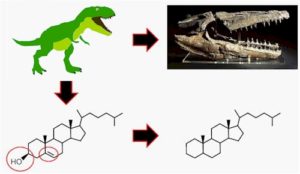Biomarker এর ব্যবহার একটি বিজ্ঞান ভিত্তিক গবেষণা যে ওই Biomarker গুলো পাওয়া সাপেক্ষে পৃথিবীর ঘটে যাওয়া ঘটনা গুলো বের করা যাবে।
বিভিন্ন ভু তাত্ত্বিক স্তরে সংরক্ষিত আছে এমন ঘটনা যেমন সমুদ্রের আম্লতা বৃদ্ধি, বৈশ্বিক তাপমাত্রা ইত্যাদি।

How to use biomarkers?
Biomarkers are the most powerful proxies for the interpretation of the earth’s paleoenvironments and the paleo-history. If we don’t find any fossils from the rocks then biomarker study can help us to know the historical past of the earth.
Biomarkers are the geochemical fossil-derived lipid of the organic matter preserved in the sedimentary rocks. after the diagenesis process the organic matter breaks down into the stable unit compound and that stable unit compound is called the Biomarker, eg. pristane and phytane.
Below is the list of Biomarkers proxies and the indication of the environmental deposition and the environmental conditions. The above list was prepared based on Xie et al,. (2017).
List of biomarkers used in the research to reveal the earth’s history.
| Proxy name | Proxy calculation | Proxy interpretation and sources | Implications for Shangsi section |
| Pr/Ph | The relative abundance of Pristane to Phytane | 1) Redox condition: < 1 anoxia, >1 oxic condition; (Powell and McKirdy, 1973, Didyk et al., 1978, etc.)2) Pr/Ph>3 in fluvial/deltaic sediments ( Hughe et al., 1995)3) Elevated Pr/Ph related to the contribution of tocopherol from some cyanobacteria, such as Anabaena variabilis, Nostoc muscorum and Fremyella diplosiphon (Powls and Redfearn, 1967; Hughes and Tove, 1982; Goossens et al., 1984) | Indication to enhanced terrestrial input when Pr/Ph is > 1.5 and shows a correlation with C30M/C30HP, but to the redox condition when Pr/Ph is <1.5 and the corresponding C30M/C30HP is low |
| C31 2-MHP | The relative abundance of C31 2-methylhopane to the total amount of C31 2-methylhopane and C30 hopane | Multiple biological origins, including cyanobacteria (Summons et al., 1999), methylotrophs and symbiotic nitrogen-fixing bacteria (Bisseret et al., 1985; Vilcheze et al. 1994), anaerobic purple non-sulfur bacteria (Rashby et al. 2007) and Alphaproteobacteria (Ricci et al. 2015) | Nitrogen-fixing bacteria including cyanobacteria due to the correlation with stratification index and AI at Shangsi, and the comparable trend with nitrogen isotope composition |
| C30M/C30HP | Ratio of C30 Moretane to C30 Hopane | Terrestrial weathering (Xie et al., 2007), or soil contribution (French et al., 2012) | Enhanced land erosion |
| r/C30HP | Relative abundance of Gammacerane to C30 Hopane | 1) An indicator for water column stratification (Sinninghe Dameté et al., 1995) because of its origin of bacterivorous ciliates (Mallory et al., 1963; Elliott, 1973) thriving in the oxic-anoxic interface (Werne et al., 2002)2) Additional source from Rhodopseudomonas palustris (Kleemann et al., 1990; Rashby et al., 2007), the anoxygenic (purple non-sulfur) phototrophic bacteria (Birgel et al., 2015) | Oceanic stratification as well as anoxic conditions |
| C33 ACH | Abundance of C33 n-alkyl cyclohexane | Presence of Acritarchs (Nabbefeld et al., 2010; Hays et al., 2010) | Acritarchs |
| Isorenieratane, aryl isoprenoids | Abundance of Isorenieratane or C13-C22 aryl isoprenoids | Photic zone euxinia due to their origin of green sulfur bacteria (Summons et al., 1987; Grice et al., 2005a) | Photic zone euxinia |
| C27/C27-29 Sterane | The relative abundance of C27 Steranes to the total amount of C27, C28, and C29 Steranes | 1) Different algae origins in marine sediments (Volkman et al., 1998), and specifically, C27 from red algae, C29 from green algae (Kodner et al., 2008)2) Relative abundance of marine algae and land plants (Moldowan et al., 1985)3) Metazoan grazing: alter C28 and C29 to C27 and C26 (Kodner et al., 2008) | Variation of specific marine algae (red algae vs green algae) |
| PAHs/Phe | The relative abundance of the total amount of pyrolytic PAHs to Phenanthrenes |